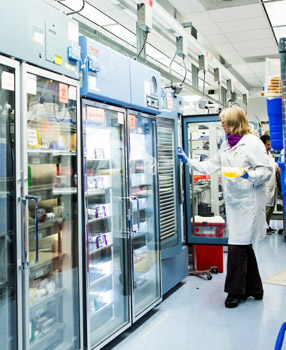SPRING 2013 CONTENTS
Home
Vital fluid
What we know about blood
Roll up your sleeve
There's still no substitute for blood
Life of blood
A guide to the cells coursing through your veins
Blood quest
The battle to protect transfusions from HIV
Against the flow
What's behind the decline in Blood transfusions?
Blood, sweat and fears
A common phobia's odd pathophysiology

DOWNLOAD PRINTABLE
ISSUE (PDF)


Special Report
A rare type
Stanford's extraordinary blood bank
By Susan Ipaktchian
Photo by Erin Kunkel
Dianne Geary, components and distribution supervisor, in the blood centerís distribution area.
For 35 years, thousands of hospital patients in the Palo Alto area have directly benefited from the blood provided through the Stanford Blood Center. But because of its research activities, the center also affects the lives of people throughout the world.
Unlike most blood banks, the Stanford Blood Center has a dual mission: to supply blood and blood products to patients, and to engage in research focused on understanding and developing treatments for blood diseases and blood-borne disorders.
Currently, the blood center provides about 100,000 pints of blood and blood components each year to patients at seven hospitals, including Stanford Hospital & Clinics and Lucile Packard Children’s Hospital. In fact, the need for a reliable source of highly purified blood for patients at Stanford’s two hospitals — many of whom have fragile immune systems — was a motivating factor in establishing the blood center in 1978.
But while blood banking may be the most visible aspect of its work, the Stanford Blood Center is also integrated into the research activities of the School of Medicine. With donors’ permission, portions of blood left over from donations are set aside for different types of research. This includes extra tubes of blood not needed for testing, or white blood cells, which are removed to minimize reactions in transfusion recipients. While other blood banks routinely discard the white blood cells, the Stanford Blood Center makes them available to researchers who study their functions.
In some cases, researchers at the School of Medicine who are studying patients with a specific disease may use blood samples from healthy donors as a control sample for an experiment. Or scientists at the blood center may use the samples to test new blood-screening processes.
Some of the current research involving the blood center includes efforts to improve the success of organ transplants. Scientists hope to develop new diagnostic tests that would better identify the degree of genetic match between the donor and the recipient in order to prevent the recipient’s body from rejecting the organ. Additionally, they are working to develop better ways of detecting an imminent attack by the recipient’s immune system against the transplanted organ.
Other researchers are examining the potential of manipulating dendritic cells (a type of immune cell) to treat cancer and other types of diseases. This approach, conceived of more than 20 years ago by Ed Engleman, MD, director of the blood center and professor of pathology, laid the groundwork for a vaccine approved for use in treating advanced prostate cancer.
And Susan Galel, MD, operations director for the blood center and an associate professor of pathology at the medical school, conducts research to make the blood-banking process more effective and efficient.
“There aren’t many blood banks that are involved in research, but it’s a critical part of our mission,” Galel says.

